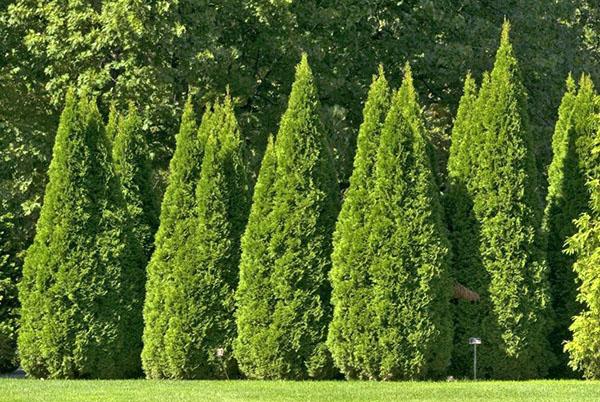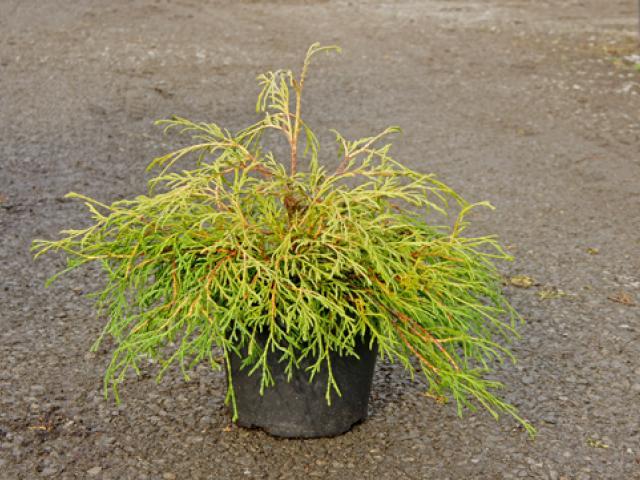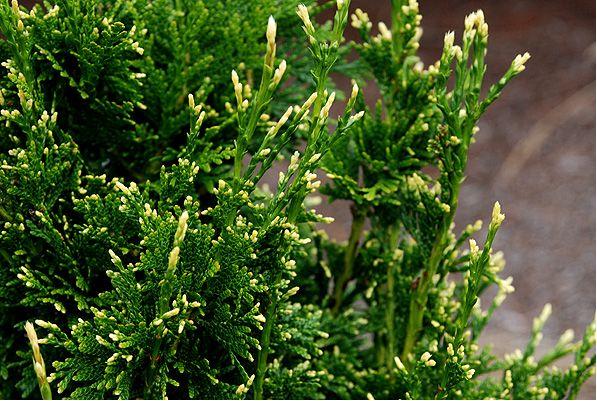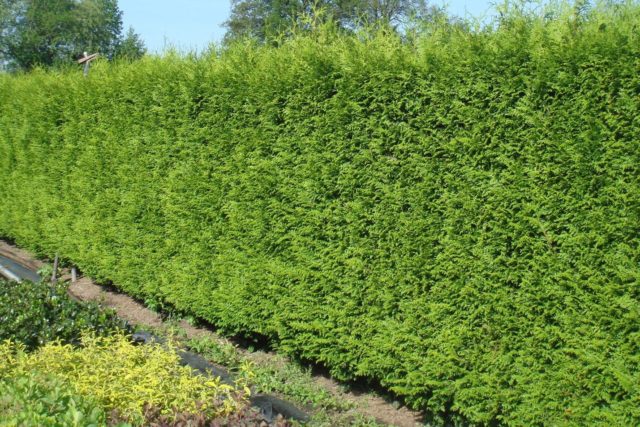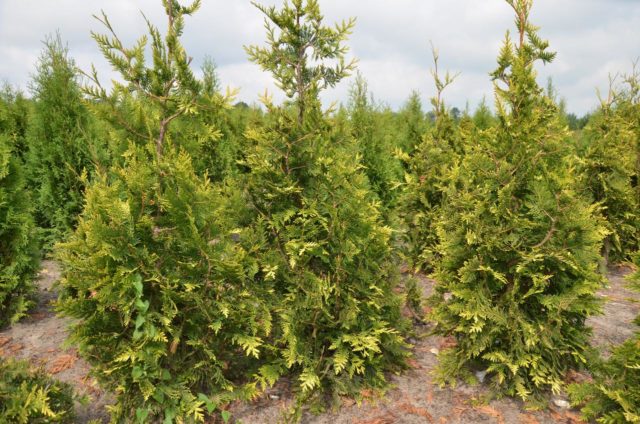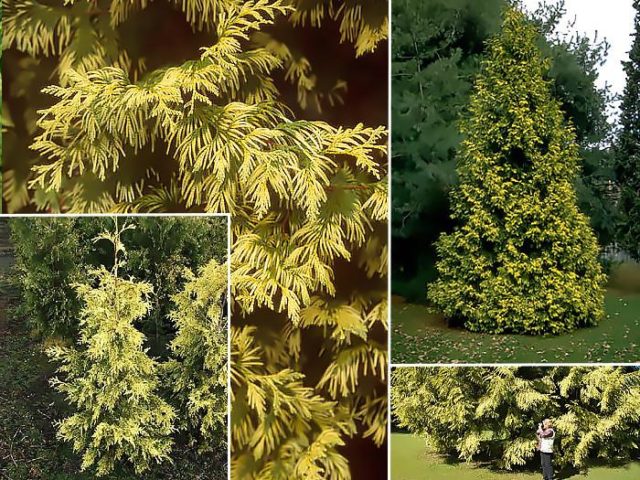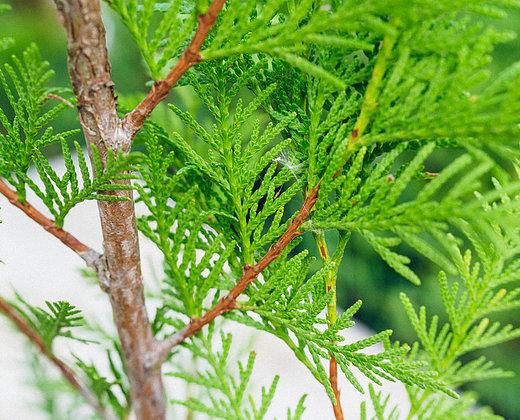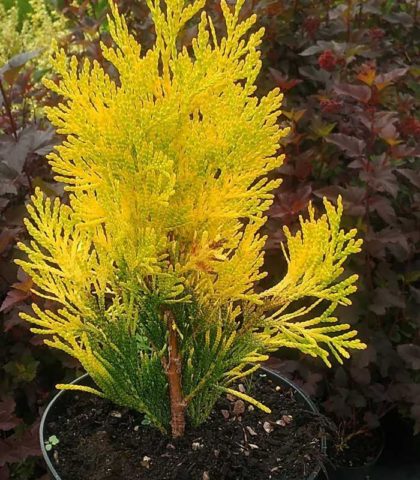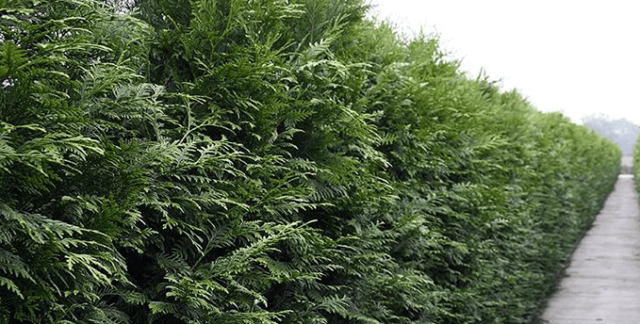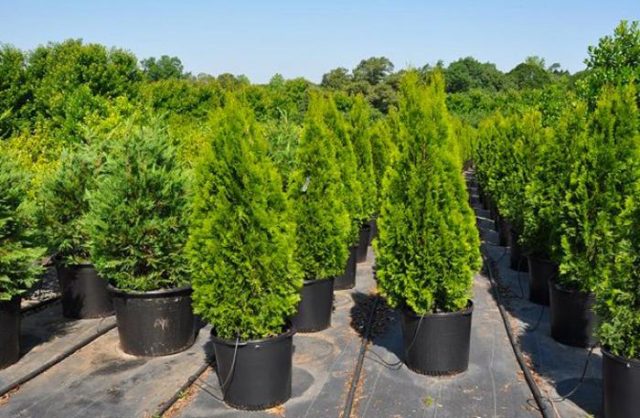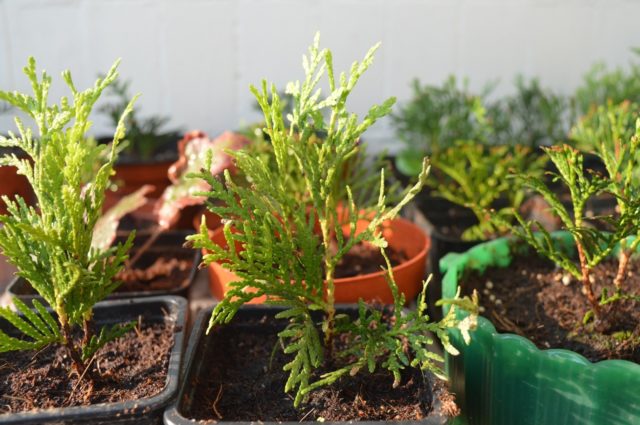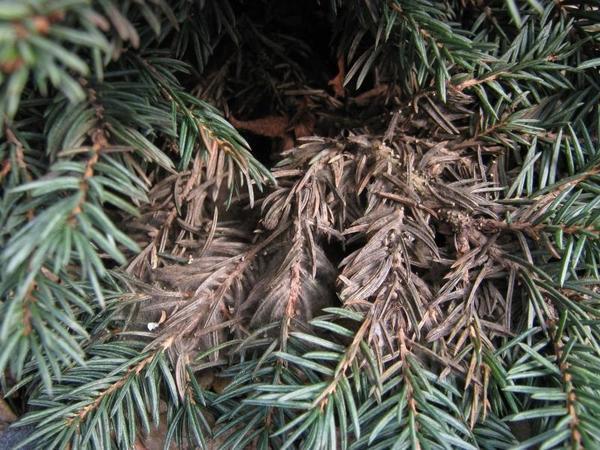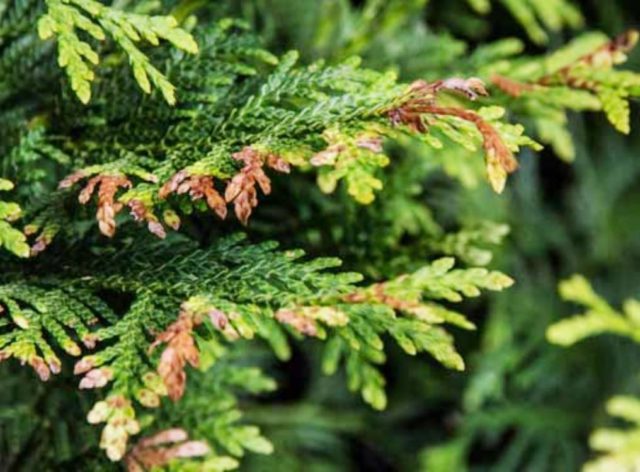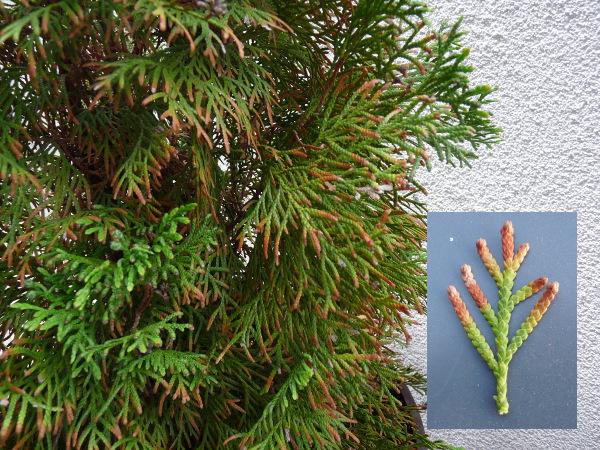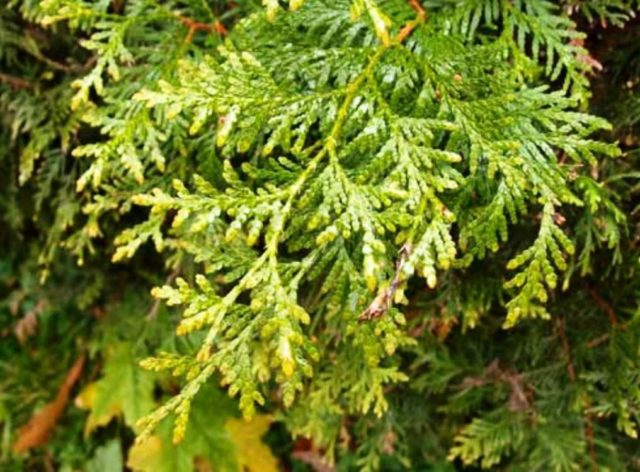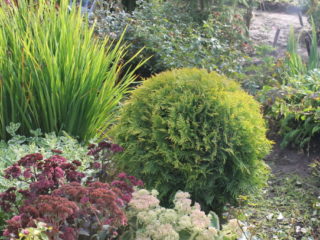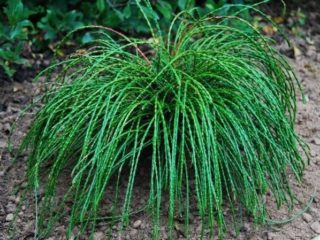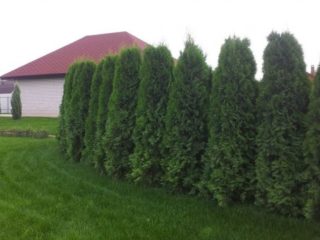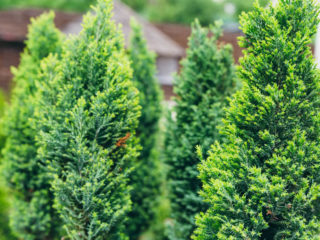Content
Thuja folded is one of the most common evergreen conifers in landscape design. She represents the Cypress family, a kind of gymnosperms, genus Tui. The tree, which originates from East Asia and North America, is actively used by landscape designers in the creation of hedges and other compositions. Folded thuja has many features, so before buying a plant, it is important to read its description and photo, find out all the rules for planting and maintenance.
General description of folded thuja
Thuja folded is an evergreen tree or shrub with a dense crown formed by shoots branched in one cavity. Under natural conditions, a culture in adulthood can reach up to 60 m in height with a diameter of 2.5 - 3 m. From above, the trunk of the ephedra is covered with a fibrous crown of a reddish-brown hue. Thanks to this feature, the folded thuja was given another, unofficial name - "red cedar". The plant has a fairly dense pyramidal crown and rather narrow leaves (each such needle reaches no more than 1 mm in width). With age, they begin to lay on top of each other and acquire a shiny gloss on the front side. On the back of the needles, you can see pronounced white stripes.
The fruits of the folded thuja are cones that reach about 12 cm in length and have an oval-oblong shape. One thuja cone usually contains two flat seeds with two wings.
Folded thuja varieties
Thuja folded has many varieties, each of which differs in its appearance and decorative qualities. Below are the most common types of wood with photos and descriptions.
Kager's Beauty
Thuja folded Kagers Beauty is an evergreen conifer of the Cypress family with loose, spreading needles. In adulthood, the ephedra reaches no more than 0.5 m in height with a diameter of 0.6 m. This is a tree with a superficial root system, especially sensitive to soil compaction and scaly needles of a gray-green color. It prefers to grow in a well-lit area or in a slightly shaded place, it is demanding on the quality of the soil: it must be fertile and well-moisturized soil. The folded thuja Kagers Beauty acquires its best color in sunny areas, while the shade gives the tree a darker shade. Thuja varieties Kagers Beauty tolerates drafts and strong winds well, but is very sensitive to dry weather, and especially needs frequent watering during dry periods.
Can-Can
According to the description, folded thuja Kankan is an evergreen coniferous tree, reaching no more than 1.5 m in height at maturity, with a cone-shaped crown. The needles of the Kankan variety have a dark green color with young growths of a light shade. Ephedra grows rather slowly, the annual rate is only 10 cm.
The tree is characterized by shiny, scale-like flat needles that adhere tightly to the shoots. Folded thuja varieties Kankan do not change the color of their needles in winter, for which it is especially appreciated by landscape designers.This is a tree with dense, upward-pointing shoots that become denser with age. It feels best in sunny and semi-shaded areas on fertile, well-moisturized and drained soil. It is easy to cut and shape the culture, which allows you to use the folded cancan to create a hedge. In addition, it is often used in single plantings in prominent places, in coloristic landscape compositions, for decorating an alley, a garden path or a rocky area.
Gelderland
Description of the plant: Thuja folded Gelderland is an evergreen tree with miniature needles that can change their color: in the summer they are rich green, which in winter changes to bright yellow. Often this type of thuja is used in group plantings, to decorate a patio or balcony (when grown in a pot). In adulthood, the tree reaches 4.5 m in height.
The Gelderland variety is distinguished by its endurance and unpretentiousness in cultivation: this folded thuja takes root well in almost any soil, as well as in a lit or semi-shaded area. Its needles do not fade in the sun at high temperatures in summer, and in winter the branches are able to withstand even the strongest piles of snow, while retaining all their decorative qualities.
At the initial stage, the Gelderland variety grows rather slowly, but with age, the growth rate increases significantly. Despite the fact that the plant can grow well in bright sun, it is very difficult to tolerate drought and needs regular watering. Gardeners consider the seed method to be the best way to propagate this variety of folded thuja.
The tree has a high level of frost resistance, it is not demanding on the level of air humidity, which greatly simplifies its care. Despite this unpretentiousness of the variety, it is not recommended to plant it in places of direct sunlight: an area with diffused light would be the best option. The variety needs moderate watering on normal days and a little more frequent during dry periods.
Zebrina
Folded thuja varieties Zebrina is an evergreen conifer with decorative needles of a zebra-like color and a conical crown. At the initial stages of growth, the needles are loose in structure, but with age they become denser. The Zebrin variety is considered one of the best representatives of variegated conifers. At the age of 10 years, such a thuja can reach more than 2.5 m in height and 1.5 m in width. Its annual growth at a young age is 10 - 20 cm, at a mature age - 15 - 30 cm. Thuja folded Zebrina varieties are characterized by shiny, scaly flat needles with yellow-white stripes, which adheres tightly to bright green shoots. The tree does not change its color and texture in winter. A feature of the Zebrin variety is the shoots hanging down: because of this, gardeners recommend cutting the tree twice a year. Thuja fruits are represented by small cones (1 - 1.5 cm in length), which, when ripe, acquire a brown color. Folded thuja Zebrina thrives best in semi-shaded or sunny areas on fertile, moist, well-drained soil with an acidic reaction. The culture tolerates shearing and shaping well, is able to quickly recover and compact the crown, which gives the plant a special value in creating hedges. With proper care, ephedra can easily adapt to city conditions.
Zebrina Extra Gold
Folded thuja varieties Zebrina Extra Gold is one of the most common varieties of golden thuja with large needles and a columnar crown. This ephedra is especially prized for its rich decorative qualities. In adulthood, it reaches up to 2 m in height and 1.2 m in width. In the summer and autumn periods, the thuja needles have a zebra-like color, which is why the tree got its name.The growth rate of folded thuja Zebrina Extra Gold is estimated as fast: the annual growth rate is up to 15 - 20 cm. At the end of the summer period or at the beginning of autumn, small blotches of green begin to appear on the needles of the plant. The tree grows well in fertile soils and illuminated areas. The Zebrina Extra Gold variety is highly valued by designers who use thuja for decoration and planting of squares, gardens and parks, as well as for specimen plantings - as a trellis plant.
Atrovirens
Thuja folded of the Atrovirens variety is an evergreen coniferous plant whose habitat is the Pacific coast, as well as the territory from Northern California to Southern Alaska. The variety often grows in damp, humid, swampy areas near the riverbank, in lowlands and shady forests, in areas with abundant rainfall and a cool climate in summer, and relatively mild in winter. In natural conditions, Thuja folded Atrovirens is often found together with other varieties of conifers.
The ephedra is presented in the form of a columnar tree, on which there are very densely located shoots and branches directed strictly vertically. The conical shape of the thuja crown is able to persist throughout the life of the tree, and with age it becomes slightly wider. Mature folded thuja of the Atrovirens variety can reach up to 15 m in height and 3.5 m in width. The growth rate of the tree is quite high: its annual growth is up to 30 cm in height and more than 10 cm in width.
This is a plant with green, shiny scaly needles, which are oppositely located on the shoots. The fruits of the ephedra - common for this species - are oblong-ovoid cones up to 12 mm in length. In summer, they are green, which changes to brown in winter.
Thuja folded Atrovirens has a high level of shade tolerance and frost resistance, develops well on any acidic or alkaline soil, undemanding to the level of pH and soil moisture. The variety normally tolerates the conditions of even a large city, it is wind-resistant, and quickly recovers after shearing or shaping.
It is best to purchase seedlings of this type of thuja in plastic containers with fertilizers, because this way they are not exposed to rot, which often damages the root system. Such a tree will take root much faster in a new planting site.
Goldy
According to the Description, Thuja folded Goldie is a new variety, it is considered one of the brightest representatives of this variety, with beautiful yellow-green needles, which retain their richness even in winter. The plant practically does not need to be cut and retains the correct conical shape of its crown throughout its life. In adulthood, the height of the Goldie variety is up to 2.5 m with a diameter of 1.5 m.Landscape designers use it to form single plantings in prominent areas, to create contrast in low coniferous hedges, as well as for individual landscape compositions. The tree has an average growth rate, its annual growth is 10 - 20 cm, at the age of 10 years it reaches more than 1.5 m in height. This is a variety with dense, rather short and dense shoots and thickened golden yellow needles pointing up. The tree practically does not change its color in autumn. Thuja folded Goldie has a superficial root system, frost-hardy, grows well in sunny or slightly shaded areas. Growth in the sun gives more saturation to the color of the needles. For this type of folded thuja, a moderately humid environment is preferable. The plant is undemanding to the soil, but it develops much better in a fertile, well-drained weakly acidic and slightly alkaline soil with a lime content. When planting a tree, it is important to pay attention to its root collar: it should be strictly at ground level.Adult representatives of the Goldie variety do not need shelter for the winter, however, young seedlings at first need protection from snow piles.
It is best to buy this variety of folded thuja in a pot: then the plant can be planted without adding additional fertilizers from March to December, even in the hottest summer period.
The Goldie variety is often used to create single and group plantings, as well as when forming curbs.
Martin
Folded thuja varieties Martin is a decorative type of ephedra, which reaches more than 1.5 m in height in adulthood. This is a tree with branched into several trunks + parallel to the main one - flat shoots, raised up, which also form plates and in adulthood have a brownish tint, young ones - a rich green. The needles of the Martin variety thuja are scaly, up to 1.5 mm long, tightly adjacent to each other and to the shoots, arranged in a criss-cross pattern. By rubbing a few leaves, you can feel the characteristic coniferous aroma of the plant. Every year, fruits appear on the ephedra - cones of a spherical shape of a brown-brown color up to 1.5 cm in length, with slightly curved scales. They contain oblong brown seeds.
The area of use of the folded thuja variety Martin is not limited: it is grown both as a houseplant and as a tub plant in the winter garden. Designers use a tree to form single and mass plantings in the backyard. The Martin variety produces a good live coniferous hedge that protects against dust and noise. This type of folded thuja is quite unpretentious in terms of keeping conditions, it develops well in areas with a temperate climate, is practically undemanding to the quality of the soil, and easily adapts to urban conditions. Other advantages of the Martin variety are its easy adaptability to cutting and shaping, the ability to purify the air and maintain its bright green color throughout the year.
Excelsa
Thuja folded varieties Excelsa is an evergreen conifer with a columnar crown shape, a trunk extending to the top and vertically raised arched branches on its lower part. The Excelsa variety is one of the fastest growing representatives of thuja: its annual growth is more than 30 cm in height and 10-15 cm in width. The height of the ephedra in adulthood can be from 12 to 15 m, and the width is 3-5 m.
Thuja folded Excelsa grows best on moist, nutrient-rich drained, cultivated, acidic or alkaline soil. A serious advantage of the variety is its high level of frost and wind resistance, which allows landscape designers to use it to create living coniferous hedges. The tree is also able to easily endure the conditions of a large city, adapts well to cutting and shaping, and retains its rich green color even in winter. The fruits of the Excelsa variety are rounded brown cones. The plant also has scaly, rough, shiny needles of a dark green hue. This type of folded thuja is not picky to care for, the only important fact in the maintenance of the tree is the level of moisture in the soil and air.
You can find out more information about some varieties of folded thuja, the features of their growth and cultivation, in the video:
Application in landscape design
Many varieties of folded thuja (Kankan, Kagers, Western) are used to decorate garden and summer cottages. Almost all plant varieties adapt well to shearing and shaping, which allows the tree to be quickly shaped to the desired shape. Most tree varieties are undemanding to maintain and are able to maintain their rich green color throughout the year.Thanks to such rich decorative properties, folded thuja has a fairly wide range of applications: it is used to design single and group plantings, create hedges, as well as to create landscape compositions such as rock gardens, rockeries, mixborders, as well as in container versions.
Single plantings of folded thuja look good near water or on lawns, especially in combination with various types of other ornamental plants. Some varieties of coniferous plants have an unusual crown shape and the aroma of needles, which makes the folded plant an indispensable element in the landscape gardening of the garden and suburban area.
Breeding features
In order to grow as many healthy seedlings of thuja folded giant as possible, it is best to get the planting material yourself. The tree can propagate in two ways: seed and cuttings.
If the priority is not to preserve the plant variety, then you can choose the seed propagation method. To do this, at the end of summer, you need to collect folded thuja seeds and immediately plant them on light and moist soil. In winter, the crops must be covered with foil. If sowing is carried out in the spring, then the seeds must first go through the process of monthly stratification.
In order for a new folded thuja plant to retain all the decorative properties of the mother tree, propagation is best done using green or semi-lignified cuttings. The most qualitative process of root formation takes place with the help of planting material, which was harvested at the end of July.
It is best to root cut twigs in the garden, under the crown of a tree.
- First you need to dig up the planting area and add peat.
- Pour a layer of sand on top, which will prevent damping off.
- Plant folded thuja branches previously soaked in Epin or Kornevin at an angle to the depth of a layer of sand.
- Top with a jar or bottle.
It is allowed to transfer the folded thuja to a permanent planting site not earlier than next spring.
Planting and leaving
For planting folded thuja, it is best to choose a well-drained soil with a high level of moisture: dry soil can significantly slow down the growth of a tree, and its crown will gradually thin out.
In order for the folded thuja to have time to get stronger by winter, it is best to plant the plant in the spring. The planting hole should be about one meter deep with a drainage layer at the bottom. Do not deepen the root collar of the plant much when planting.
When planting a folded thuja for a hedge, remember the distance between the conifers: it should be within three meters. Forming an alley, the space between plants is increased to five to six meters.
In the first month after planting, the plant needs regular watering: once every seven days, and in areas with an arid climate - twice a week. One folded thuja seedling accounts for more than 10 liters of water. In the evening, you can spray the crown of the plant.
The culture adapts well to transplantation. It is best to hold an event for young seedlings in the spring, and for adult plants at any time of the year.
Growing features
Mature specimens of folded thuja do not need special conditions of detention. Particular attention should be paid to young seedlings, providing them with proper care. In the spring, folded thuja especially needs feeding. Nitroammophosphate and any set of complex fertilizers are best suited.
In the spring, pruning is carried out, removing all dried and unnecessary branches, and, if desired, form the necessary crown shape.It is equally important to mulch around the ephedra with peat, bark and needles. This helps to maintain soil moisture as well as protect against weeds.
Adult plants tolerate winter well (folded thuja can withstand temperatures below 30 degrees of frost), however, it is better for young seedlings to provide reliable shelter from frost and snow piles.
Pests and diseases
Like most conifers, folded thuja has a strong natural immunity, however, in unfavorable conditions, the risk of infection of the tree can increase several times. The most common diseases of folded thuja are:
- Brown shute - often the disease manifests itself in the spring, after the snow thaws. On the bright green needles of the plant, yellow, red-brown or black needles begin to appear. The affected areas of the tree begin to cover the oblong fruiting bodies of pathogenic fungi. Having found the first symptoms of the disease, it is necessary to begin immediate treatment: cut and burn all damaged branches, and the ephedra itself must be sprayed with a 2% solution of copper sulfate or a special drug - Fundazol.
- Gray rot - often affects young ephedra seedlings. This disease develops due to too dense planting, lack of ventilation and low light. Thuja shoots become brownish. At the initial stage of the disease, spraying folded thuja with copper sulfate will help save the plant.
- Fusarium - Thuja disease of fungal nature, caused by pathogenic bacteria of the genus Fusarium. This is one of the most insidious coniferous infections that begins at the roots of the tree, making it impossible to see the first signs of the disease. After yellowing and complete drying, there is no point in treating the tree. That is why it is very important to carry out the prevention of thuja: before planting, spray with fungicides and prevent waterlogging of the soil in the territory. If in a group planting one thuja seedling died from fusarium, the remaining trees need to be watered under the root with a Fundazol solution, however, it should be understood that such protection cannot give a 100% guarantee.
- Stem rot - often this infection affects thuja with mechanical damage to the bark and wood. Getting into the formed cracks, moisture begins to turn injured places into rotting breeding grounds of parasitic microflora. To avoid the disease of folded thuja, it is important to treat damaged areas of the bark with garden varnish or special preparations in time.
- Phytophthora - the roots of a plant affected by this infection begin to gradually rot, the bark at the bottom of the trunk gradually softens, its surface is covered with pinkish and dirty white blotches. The wood under the affected areas of the bark begins to turn brown, a characteristic smell of rot appears, the needles grow dull and soon completely crumble. If signs of phytophthora are found, the thuja should be immediately treated with a preparation containing copper, however, the best option would be to dispose of the diseased specimen: this is guaranteed to prevent the spread of the disease to other seedlings.
Conclusion
Thuja folded is an evergreen coniferous plant, which is actively used to decorate garden and summer cottages. Ephedra has many varieties, each of which is characterized by its own unique decorative properties. The plant is unpretentious to care for and is able to maintain its green color throughout the year. However, having decided to purchase a folded thuja, it is extremely important to observe agricultural techniques, then the thuja will delight with its beautiful appearance all year round.
